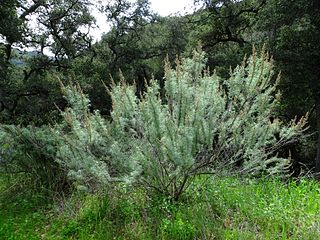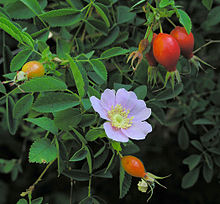
A rose is either a woody perennial flowering plant of the genus Rosa, in the family Rosaceae, or the flower it bears. There are over three hundred species and tens of thousands of cultivars. They form a group of plants that can be erect shrubs, climbing, or trailing, with stems that are often armed with sharp prickles. Their flowers vary in size and shape and are usually large and showy, in colours ranging from white through yellows and reds. Most species are native to Asia, with smaller numbers native to Europe, North America, and Northwest Africa. Species, cultivars and hybrids are all widely grown for their beauty and often are fragrant. Roses have acquired cultural significance in many societies. Rose plants range in size from compact, miniature roses to climbers that can reach seven meters in height. Different species hybridize easily, and this has been used in the development of the wide range of garden roses.

Rosa rugosa is a species of rose native to eastern Asia, in northeastern China, Japan, Korea and southeastern Siberia, where it grows on beach coasts, often on sand dunes. It is naturalized in much of Europe and parts of the United States and Canada. It should not be confused with Rosa multiflora, which is also known as "Japanese rose". The Latin word "rugosa" means "wrinkled", referring to the wrinkled leaves. Often used as an ornamental plant, it has become invasive in parts of Europe, North America and South America.

Viola pedunculata, the California golden violet, Johnny jump up, or yellow pansy, is a perennial yellow wildflower of the coast and coastal ranges in California and northwestern Baja California. The common name "Johnny jump up" is usually associated with Viola tricolor however, the introduced garden annual.

Salvia spathacea, the California hummingbird sage or pitcher sage, is a species of flowering plant in the family Lamiaceae, native to southern and central California growing from sea level to 610 m (2,001 ft). This fruity scented sage blooms in March to May with typically dark rose-lilac colored flowers. It is cultivated in gardens for its attractive flowering spikes and pleasant scent.

Frangula californica is a species of flowering plant in the buckthorn family native to western North America. It produces edible fruits and seeds. It is commonly known as California coffeeberry and California buckthorn.

Artemisia californica, also known as California sagebrush, is a species of western North American shrub in the sunflower family.

Rosa nutkana, the Nootka rose, bristly rose, or wild rose is a 0.6–3.0-metre-tall (2–10-foot) perennial shrub in the rose family (Rosaceae).

Rhus integrifolia, also known as lemonade sumac, lemonade berry, or lemonadeberry, is a shrub to small tree. It is native to the Transverse and Peninsular Ranges and the South Coast regions of Southern California. This extends from Santa Barbara County and the Channel Islands to San Diego County and extending into north-central Pacific coastal Baja California and its offshore islands such as Cedros Island.

Malosma is a plant genus which contains only a single species, Malosma laurina, with the common names laurel sumac and lentisco (Spanish). Malosma laurina is found along the southern California and Baja California coasts of the Pacific Ocean.

Rosa carolina, commonly known as the Carolina rose, pasture rose, or prairie rose, is a perennial shrub in the rose family native to eastern North America. It can be found in nearly all US states and Canadian provinces east of the Great Plains. It is common throughout its range and can be found in a wide variety of open habitats, from thickets and open woods to roadsides and along railroads.

Rosa gymnocarpa is a species of rose native to western North America. It is known by the common names dwarf rose, baldhip rose, and wood rose. It grows in shady, damp, and rich forests.

Rosa minutifolia is a species in the genus Rosa. It is also known by the common names Baja rose, Baja littleleaf rose, and small-leaved rose.

Dudleya edulis is a species of perennial, succulent flowering plant of the Crassulaceae, known by the common names fingertips, lady-fingers, mission lettuce, or simply the San Diego dudleya. The common name "fingertips" denotes the finger-like shape of the leaves; the specific epithet edulis refers to the Kumeyaay people's traditional foraging and consumption of the plant's young scapes. Dudleya edulis is native to the dry, coastal cliffs and chaparral hills of Southern California and northern Baja California, where it has adapted to absorb as much moisture as possible from the nightly fog and marine layer which forms over the Pacific Ocean and gradually moves slightly inland, typically covering all plants and stationary objects in dew. In addition to its inherent drought-tolerance and xeric qualities, this species is also highly salt-tolerant, as it grows almost exclusively facing the ocean, often in exposed settings where it is subjected to regular periods of extreme wind and weather. The species may be found growing on rocky hillsides, sandstone sea cliffs, chaparral habitat, arid canyons, or rooted between exposed, bare rock crevices.

Oenothera californica, known by the common name California evening primrose, is a species of flowering plant in the evening primrose family.

Ribes californicum, with the common name hillside gooseberry, is a North American species of currant. It is endemic to California.

Rosa pisocarpa is a species of rose known by the common name cluster rose or swamp rose. It is native to western North America from British Columbia to northern California, where it generally grows in moist habitats. It is a shrub sometimes forming a thicket, and growing up to 2.5 meters tall. The stems can be dark red or blackish and are often studded with straight, paired prickles at nodes. The leaves are each made up of several toothed oval leaflets, the terminal leaflet up to 4 centimeters long. The inflorescence is a cyme of up to 10 flowers with pink petals each up to 2 centimeters in length. The fruit is a rose hip about a centimeter wide. The hips are pear- or egg-shaped and borne in clusters, and are decorative in fall and early winter, when they are red or reddish-purple and contrast with yellow foliage. Fall foliage can be yellow or dark red.

Rosa woodsii is a species of wild rose known by the common names Woods' rose, interior rose, common wild rose, mountain rose, pear-hip rose, and prairie rose.

Sidalcea malviflora is a species of flowering plant in the mallow family, known by the common names dwarf checkerbloom, Greek mallow, prairie mallow and dwarf checkermallow.

Rosa setigera, commonly known as the climbing rose, prairie rose, and climbing wild rose, is a species of shrub or vine in the Rosaceae (rose) family native to central and eastern North America.





















